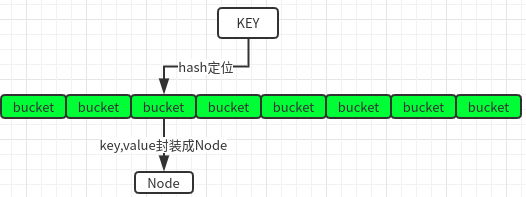概要
容器,这个概念在我刚开始接触的时候,其实很模糊,到处都可以看到容器这个概念。到现在我的理解起来就很简单了,就是一个装载空间,每个容器有它一定的功能,可进可出,就是 container。像并发容器,就像 ConcurrentHashMap,ConcurrentSkipArrayList,LinkedBlockingQueue 等,可以装载 java 对象,提供线程安全的一些功能。由于目前我常用的 jdk 是 8 的版本,所以这一次就聊 jdk8 里面的一些并发容器,至于网上经常拿 jdk7 和 jdk8 的并发容器进行比较,而且面试也可能问,但是官网上已经下载不到了,我也就懒得去找 jdk7 来对比了
所以我们这次要聊的有
- Hash 和 hashMap
- ConcurrentHashMap
- ConcurrentSkipListMap和ConcurrentSkipListSet
- ConcurrentLinkedQueue
- 写时复制容器
- 阻塞队列
Hash 和 hashMap
我们先来聊一下哈希这个技术,因为接下来会使用到
- 概念:把任意一个输入通过一种算法(散列),变换成固定长度的输出,这个输出就是散列值
- 常用算法:
- 直接取余数
- md4,md5,sha 等摘要算法
位运算实现取模
这里插一个小知识,因为下面会使用到
当 b = 2^n 时,a & (b - 1) 想当于 a % b。比如 7 % 4 = 3 和 111 & 011 = 011。注意这里 b 只能是 2 的 n 次方数
hashMap 中使用哈希算法
hashmap 的实现概念如下图,将 key 进行 hash,根据 hash 值分配到桶(bucket)

- 放进(put) hashmap 的时候,根据 key 的 hash 值找到桶,封装 key, value 成 Node,添加进桶里(同一个桶里的 hash 值都是一样的)
- 查询(get) hashmap 的时候,根据 key 的 hash 值找到桶,在桶里查找 key.equals(k) 的 Node,返回 value
- 遍历 hashmap 的时候,遍历每一个桶和桶里面的 Node
jdk8 中的 hash 算法
1 | // 将 key 的 hashCode 和它本身高 16 位进行异或 |
hashmap 的主要实现思路其实就是上面说的那样,把 hash 值作为标识,然后根据标识把元素分散开来,就跟分库分表一样
hashMap 非线程安全
并发情况下,可能会出现的情况。简单的测试代码
- 多个线程同时 put,元素可能会丢失
1 | private static Map<String, String> map = new HashMap<>(); |
形成的原因也很简单,多个线程同时往一个桶里面添加 Node 的时候,会出现覆盖的现象。比如下面这一段
1 | final V putVal(int hash, K key, V value, boolean onlyIfAbsent, |
- 多个线程同时 put,get 获取的值可能为 null
这里就不贴代码了,可以看 简单的测试代码
原因 resize 的时候,tab = newTable,此时还没有元素,get 得到了 null。其实还有其他原因
- jdk7 Entry链表可能形成环形数据结构,一旦形成环形数据结构,Entry的next节点永远不为空,就会产生死循环获取Entry
这个网上有一大堆分析,这里就不分析了。简单的说就是因为 jdk7 是头部新增数据的,即 bucket -> newOne -> oldOne,java8 解决了这个问题,即 bucket -> oldOne -> newOne。两个线程同时做扩容操作,因为头插法很可能直接将链表反转(jdk7 的 bucket 是链表),当一个线程刚确认好 当前节点和一个节点时,另一个线程将链表反转了,这个线程继续执行,就会出现环,即 k1 -> k2,k2 -> k1。形成环之后,map.get(K) 时会遍历链表,由于链表形成环了,遍历就死循环了
ConcurrentHashMap
ConcurrentHashMap 和 HashMap 的思路差不多,只是在 put,remove,扩容等操作的时候,加了锁或者使用 CAS 操作,保证在并发情况下的安全性
ConcurrentHashMap jdk7 和 jdk8 的区别
这里聊一下主要区别
- 取消了 segment,直接使用一个 node 数组,锁的粒度更小,减少并发冲突的概率
- 链表+红黑树,纯链表O(n),红黑树O(logn),性能提升很大
ConcurrentHashMap 数据结构和关键变量
ConcurrentHashMap 使用到的几个数据结构,Node, TreeNode, TreeBin。java8 桶(bucket) 可以是链表,也可以是红黑树,用来装载 key-value,当链表元素个数超过阈值 8,将转换成红黑树;当红黑树元素个数少于阈值 6,将转换成链表
1 | // 链表使用的 Node 存储 key,value。 val 和 next 是 volatile 的,保证可见性 |
其实还有两个数据结构 ForwardingNode 和 ReservationNode。以下是几个常量
1 | // 桶数组的最大个数 |
变量
1 | // 数组容器,就是桶。java8 是懒初始化的 |
ConcurrentHashMap 构造方法
跟 jdk1.7 不同,jdk1.8 的构造方法是懒初始化的,等具体使用到某个桶的时候才做初始化工作。而 jdk1.7 有 segment 概念,构造方法会初始化好 segment 数组
1 | // 默认容量16 |
ConcurrentHashMap put
put,如果 key 已经存在,覆盖并返回原来的值;如果 key 不存在,填上并返回 null
这里桶称之为 bin,容器的意思
通过 CAS 操作和 对首节点 synchronized 加锁,保证添加元素的时候,该 bin 下的操作是线程安全的
1 | public V put(K key, V value) { |
ConcurrentHashMap get
get 方法是没有加锁的,但是跟 HashMap 不同的是,在扩容完成的时候才会 table = nextTable,所以不会出现获取到的值为 null 的情况
1 | public V get(Object key) { |
ConcurrentHashMap 扩容和 size
putVal 的时候有一个 addCount 方法,里面判断元素个数是否达到 sizeCtl 阈值,如果达到阈值,则进行扩容操作。扩容操作是翻倍扩容,容量为原来的 2 倍
1 | private final void addCount(long x, int check) { |
size 方法里面主要是 sumCount 方法,这里是没有加锁的。在并发情况下,size 方法得出的结果不一定是精确的,是一个估值
1 | public int size() { |
弱一致性,get、size 等方法没有加锁,会出现线程读取数据到一半,其他修改线程操作完毕,然后读取数据的线程继续执行,得到了旧的数据
ConcurrentHashMap 面试常见问题
- ConcurrentHashMap实现原理是怎么样的或者问ConcurrentHashMap如何在保证高并发下线程安全的同时实现了性能提升?
- ConcurrentHashMap允许多个修改操作并发进行,其关键在于使用了锁分离技术。它使用了多个锁来控制对hash表的不同部分进行的修改。内部使用段(1.7 Segment 1.8 Node)来表示这些不同的部分,每个段其实就是一个小的
hash table,只要多个修改操作发生在不同的段上,它们就可以并发进行
- ConcurrentHashMap允许多个修改操作并发进行,其关键在于使用了锁分离技术。它使用了多个锁来控制对hash表的不同部分进行的修改。内部使用段(1.7 Segment 1.8 Node)来表示这些不同的部分,每个段其实就是一个小的
- 在高并发下的情况下如何保证取得的元素是最新的?
- 用于存储键值对数据的HashEntry,在设计上它的成员变量value等都是volatile类型的,这样就保证别的线程对value值的修改,get方法可以马上看到
- 如何在很短的时间内将大量数据插入到ConcurrentHashMap
- 将大批量数据保存到map中有两个地方的消耗将会是比较大的:第一个是扩容操作,第二个是锁资源的争夺。第一个扩容的问题,主要还是要通过配置合理的容量大小和扩容因子,尽可能减少扩容事件的发生;第二个锁资源的争夺,在put方法中会使用synchonized对头节点进行加锁,而锁本身也是分等级的,因此我们的主要思路就是尽可能的避免锁等级。所以,针对第二点,我们可以将数据通过通过ConcurrentHashMap的spread方法进行预处理,这样我们可以将存在hash冲突的数据放在一个组里面,每个组都使用单线程进行put操作,这样的话可以保证锁仅停留在偏向锁这个级别,不会升级,从而提升效率
更多面试题会补充上来
ConcurrentSkipListMap和ConcurrentSkipListSet
- 是TreeMap、TreeSet 的并发版本
- 通过 CAS 保证线程安全性
- 使用的技术是跳表
- 典型的空间换时间技术
- 随机将元素作为索引,查询的时候使用索引会快很多
- 这里有一篇描述 redis 中使用跳表的
- 时间复杂度快赶上红黑树
ConcurrentLinkedQueue
- LinkedList 的并发版本
- 通过 CAS 保证线程安全性
- 无界非阻塞队列,底层是个链表
- add,offer 从尾部添加数据。peek(拿数据不移除),poll(拿数据要移除),从头部移除数据
1 | // 典型的自旋 CAS |
写时复制容器
- CopyOnWriteArrayList、CopyOnWriteArraySet
- 思路是要修改的时候,将数据拷贝一份进行修改,然后修改引用
- 只能保证最终一致性,因为读取的时候可能读取到旧的数组
- 适用读多写少,白名单、黑名单、商品类目的更新
1 | // 写的时候使用显示锁 |
阻塞队列
- 核心思想:当队列满的时候,插入元素线程被阻塞,直到队列不满;当队列空的时候,获取元素线程被阻塞,直到队列不空
- 使用场景:生产者消费者模式。使用容器降低生产者和消费者之间的耦合
- 常用方法(插入/移除/检查)
- 抛出异常类型:add/remove/element
- 返回值类型:offer/poll/peek
- 一直阻塞类型:put/take
- 超时退出类型:offer(time)/poll(time)
具体的阻塞队列
- ArrayBlockingQueue
- 底层实现为数组、有界
- 先进先出,需要设置初始大小
- LinkedBlockingQueue
- 底层实现为链表、有界
- 先进先出,可以不设置初始大小,默认 Integer.MAX_VALUE
- 与 ArrayBlockingQueue 区别
- 锁:ArryaBlockingQueue 只使用一个锁,LiknedBlockingQueue 使用两个锁
- 数据结构上:ABQ 直接插入,LBQ 需要先转换成节点
LinkedBlockingDeque
- 链表、有界、双向
- 双向获取和移除,工作密取有使用
PriorityBlockingQueue
- 优先级、无界
- 默认情况下,按照自然顺序;实现 compareTo; 构造 Comparetor
DelayQueue
- 优先级队列、无界
- 支持延时获取元素的阻塞队列,元素必需实现 Delayed 接口
- 使用场景:缓存系统、订单到期、限时支付
SynchronousQueue
- 不存储元素
- 每一个 put 等待 take
LinkedTransferQueue
- 链表、无界
- 跟 LinkedBlockingQueue 区别
- 多了 transfer()、tryTransfer()。先不进入队列,先查看有没有消费者,如果有,直接交给消费者
- transfer 需要等待消费者消费才返回,tryTransfer 无论是否消费,直接返回
他们的底层实现都差不多,是通过显示锁和 Condition 实现的。我们来看其中的一个
1 | public class LinkedBlockingQueue<E> extends AbstractQueue<E> |